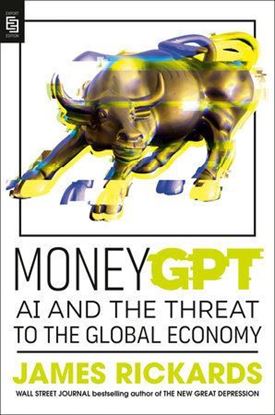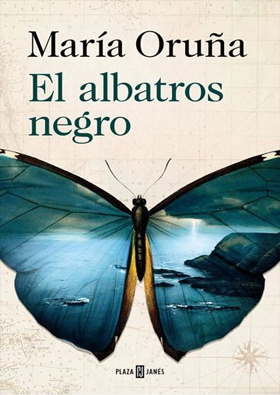

MISRULE
Feared and despised for the sinister power in her veins, Alyce wreaks her revenge on the kingdom that made her an outcast. Once a realm of decadence and beauty, Briar is now wholly Alyce’s wicked domain. And no one will escape the consequences of her wrath. Not even the one person who holds her heart.
Princess Aurora saw through Alyce’s thorny facade, earning a love that promised the dawn of a new age. But it is a love that came with a heavy price: Aurora now sleeps under a curse that even Alyce’s vast power cannot seem to break. And the dream of the world they would have built together is nothing but ash.
900
MONEYGPT
In November 2022, OpenAI released GPT-4 in a chatbot form to the public. In just two months, it claimed 100 million users—the fastest app to ever reach this benchmark. Since then, AI has become an all-consuming topic, popping up on the news, in ads, on your messenger apps, and in conversations with friends and family. But as AI becomes ubiquitous and grows at an ever-increasing pace, what does it mean for the financial markets?
In MoneyGPT, Wall Street veteran and former advisor to the Department of Defense James Rickards paints a comprehensive picture of the danger AI poses to the global financial order, and the insidious ways in which AI will threaten national security. Rickards shows how, while AI is touted to increase efficiency and lower costs, its global implementation in the financial world will actually cause chaos, as selling begets selling and bank runs happen at lightning speed. AI further benefits malicious actors, Rickards argues, because without human empathy or instinct to intervene, threats like total nuclear war that once felt extreme are now more likely. And throughout all this, we must remain vigilant on the question of whose values will be promoted in the age of AI. As Rickards predicts, these systems will fail when we rely on them the most.
1,450
MURDER ISLAND
When professor turned crime-fighter Brandt "Doc" Savage and his girlfriend Kira Sunlight land on a desert island in the middle of the Atlantic, they think they've found a perfect utopia. An escape from their tumultuous pasts.
But they don't have long to enjoy their newfound peace before they are violently separated and dragged to opposite ends of the Earth.
Doc's search for Kira takes him from the coast of Brazil to northern Europe and the jungles of the Congo, and he discovers they are entangled in a global conspiracy that is bigger he ever could have imagined.
800
MUST LOVE FLOWERS
Joan Sample is not living the life she expected. Now a widow and an empty-nester, she has become by her own admission something of a recluse. But after another birthday spent alone, she is finally inclined to listen to her sister, who has been begging Joan to reengage with the world. With Emmie’s support, Joan gathers the courage to take some long-awaited steps: hiring someone to tame her overgrown garden, joining a grief support group, and even renting out a room to a local college student. Before long Joan is starting to feel a little like herself again.
Across town, Maggie Herbert works mornings as a barista, tending to impatient customers before rushing to afternoon nursing classes. She lives with her alcoholic father, ducking his temperamental outbursts and struggling to pay the household bills. But her circumstances brighten when she finds a room for rent in Joan’s home. In the unexpected warmth of her new situation, Maggie finds a glimmer of hope for a better life. But will Maggie’s budding attraction to one of her favorite customers ruin the harmony she’s only recently found with Joan? Meanwhile, what is Joan to make of the mysterious landscaper who’s been revitalizing her garden—a man who seems to harbor a past loss of his own?
995
MY LIFE WITH THE WALTER BOYS (NETFLIX SE
Jackie's goal is perfection―perfect grades, the perfect look, getting into the perfect school. If she can achieve that, then maybe her too-busy mom and dad will take notice. But when her parents die in a tragic accident, Jackie is shipped off across the country to live with the Walters, her new guardians…who just happen to have eleven sons (plus a daughter who is basically one of the boys).
The Walter boys are loud, dirty, annoying―and, okay, some of the older boys might be Greek god level hot, but they don't think a city girl belongs on their horse ranch. How is Jackie supposed to fit into their chaotic world when she needs to keep her parents' memory alive by living up to the promise of perfect?
But as Jackie spends more time with the Walter boys, she begins to wonder if the perfection she's always strived for isn't the only way to find love after all.
750
MY NAME IS EMILIA DEL VALLE (EXP)
In San Francisco in 1866, an Irish nun, abandoned following a torrid relationship with a Chilean aristocrat, gives birth to a daughter named Emilia del Valle. Raised by a loving stepfather, Emilia grows into an independent thinker and a self-sufficient young woman.
To pursue her passion for writing, she is willing to defy societal norms. At the age of seventeen, she begins to publish pulp fiction using a man’s pen name. When these fictional worlds can no longer satisfy her sense of adventure, she turns to journalism, convincing an editor at The Daily Examiner to hire her. There she is paired with another talented reporter, Eric Whelan.
As she proves herself, her restlessness returns, until an opportunity arises to cover a brewing civil war in Chile. She seizes it, as does Eric, and while there, she meets her estranged father and delves into the violent confrontation in the country where her roots lie. As she and Eric discover love, the war escalates and Emilia finds herself in extreme danger, fearing for her life and questioning her identity and her destiny.
1,250













